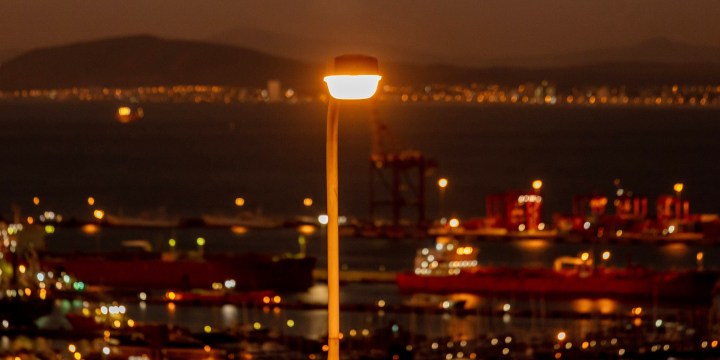RAY OF LIGHT
Eskom offers signs of hope that the power crisis has turned a corner

A month before South Africa’s general election, Eskom’s vital signs look good. Has the power utility cleaned up its act with the polls in mind, or are the reforms finally showing positive signs?
How has Eskom drastically managed to reduce the intensity of power cuts from Stage 2 and 3 in March 2024 to keeping lights on throughout April?
The state-owned entity has touted improvements in its fleet of ageing power stations spurred by the Energy Action Plan and the generation recovery plan as reasons why the lights are on. But renewables and a decline in demand seemed to have contributed to 33 consecutive days without power cuts.
This comes amid claims from opposition parties and sceptics that the streak of no load shedding is an election strategy by the ruling ANC.
On Monday, 29 April, Presidency spokesperson Vincent Magwenya said the Presidency rejected “the claims that recent improvements in the energy supply are a ploy related to the upcoming elections”.
Eskom’s top brass proffered the power utility’s winter outlook in a media briefing on Friday. The presentation by new Eskom group CEO Dan Marokane and the company’s head of generation, Bheki Nxumalo, appeared to show the power utility has made significant progress in the past year.
“We recognise that what really transpired here is a culmination of interventions started a year ago… It is important that we build on it,” said Marokane.
On the face of it, this winter looks like it could be brighter than the winter of 2023.
Eskom anticipates limiting load shedding to Stage 2, with unplanned outages expected to range from 14,000MW to 15,500MW. If this scenario happens, the power utility expects South Africa will experience, at most, about 50 days without power between now and 31 August.
Read more in Daily Maverick: Eskom forecasts ‘light’ load shedding in winter after 30-day break from rolling blackouts
Last winter, South Africans were in the dark for 153 days between 1 April and 31 August, experiencing Stage 3, 4 and 6 rotational power cuts.
Energy availability factor
While Eskom has recorded improvements in unplanned breakdowns, its energy availability factor (EAF) falls short of the target set in its recovery plan.
EAF measures the average percentage of electricity that power stations have available to dispatch energy at any one time. A high EAF indicates that Eskom’s power stations are being maintained and are operating well.
Eskom board chairperson Mteto Nyati – a former MTN South Africa and Altron CEO who was appointed chair after Mpho Makwana’s resignation in October 2023 – said the power utility had a target of 65% EAF that was set by the board for end-March 2024, which it failed to meet.
“We did not meet that. We’re currently sitting with an EAF of 61%, which is slightly less than what we had targeted,” he said.
However, contrary to his statements, publicly available Eskom data indicates the monthly EAF has not yet reached 60% but stands at 58.3% for April.
Nyati said Eskom aims to improve the EAF to 70% in March 2025.
Breakdowns
“Between April 2023 and March this year, the reliability of our power plants has improved and this is as we continue with the execution of the generation recovery plan… We saw a year-on-year improvement of 9% in unplanned losses and a 19% decline in unit trips – the latter is very important because it deals with the reliability of the fleet,” said Marokane.
This March, Eskom experienced slightly fewer unplanned losses than in March 2023 (31.8% in March 2024 compared with 34.5% in March 2023). This is the same trend when one compares unplanned losses in April 2024 (29.8%) with April 2023 when breakdowns were at 34.7%.
This past week the percentage of unplanned losses dropped to 28.6% from 33.2% at the beginning of March. Let’s not forget that the cooler weather traditionally bodes well for Eskom’s fleet of power stations, as Daily Maverick’s Ray Mahlaka reported. But overall, unplanned breakdowns are lower in March and April 2024 compared with the same period last year.
“I do think it is a notable and commendable achievement by Eskom that unplanned breakdowns are stable this year at levels that are consistently lower than those of last year, and that the energy availability factor has steadied, and not reduced further along the same downward trend as for the last five years and more,” energy analyst Chris Yelland wrote on X.
Herewith latest Eskom EAF, PCLF and UCLF data to week 16, 2024: pic.twitter.com/0CCfrLo2y0
— Chris Yelland (@chrisyelland) April 27, 2024
Dwindling demand
While Marokane said the improvement in generation performance contributed to the reduction in load shedding, he acknowledged that “demand is also declining slightly”.
Data published by Eskom shows a decline in weekly peak demand for Eskom grid power this year, compared with last year.
A continued decline in demand for Eskom grid power is the reason behind the streak of no load shedding, Yelland penned in a recent op-ed.
Yelland says this is because of, among other things, South Africa’s weak economy and the resulting generally flat overall demand for power, the increasing cost of Eskom power, load shedding, and the move to alternative energy sources by Eskom customers.
The power of renewables
Also helping to improve the electricity situation is the contribution of solar power. Eskom system operator Isabel Fick said private solar photovoltaic (PV) was making “a huge contribution” to Eskom’s electricity generation profile.
Read more in Daily Maverick: Renewable energy projects may keep the lights on longer in 2024 — we hope
Fick said there were around 11,870MW of installed renewable contributions in the country. Of that, an estimated 2,800MW of PV solar is connected directly to the Eskom grid, with another 5,440MW of “behind-the-meter” PV solar, which Fick says “would refer to rooftop PV, as well as small plants that are not connected to the Eskom system.”
Fick said that while solar power was the biggest part of private generation, it could contribute only between 9am and 3pm, leaving Eskom to pick up in the morning and evening peak demand hours.
“It means that this contribution is not available for peak periods,” said Fick.
If Eskom faces higher electricity demand, mostly during the evening peaks, it burns diesel to run its open-cycle gas turbines (OCGTs). The contribution of solar power has meant that Eskom can replenish its emergency reserves, like the OCGTs and pumped storage dams during the day, for use during peak periods.
“The usage of the OCGTs is now limited to the peak periods because we have these contributions during the daytime,” she said.
Fick said that when the country experienced inclement weather, Eskom was forced to lean more heavily on its emergency reserves.
Diesel consumption
Marokane said the reduction in load shedding was not because the power utility was burning more diesel to run its OCGTs. Rather, compared with April 2023, Eskom had spent 50% less on diesel in April 2024.
In a recent parliamentary reply, Public Enterprises Minister Pravin Gordhan revealed that Eskom spent R23.4-billion on diesel in the 2023/24 financial year.
The DA had said the burning of diesel had “remained elevated” since 31 March 2024, “creating an illusion of improved electricity supply.”
However, the power utility’s diesel spend actually decreased between March and April 2024.
From 1 to 22 April 2024, while load shedding was suspended, Eskom spent R1.4-billion on diesel to run its OGCTs, compared with R3.1-billion in April 2023.
The OCGTs generated 198 gigawatt hours (GWh) of energy between 1 and 28 April 2024, compared with 470GWh generated in April last year.
However, Eskom spent R3.3-billion on diesel in March 2024, which had 26 days of load shedding. This is R1.2-billion more than it spent on diesel in March 2023, which had 30 days of load shedding. DM



















Based on the ruling parties track record, my opinion would be more along the lines that they have temporarily opted to use alternative generation means (diesel instead of coal) at an exponentially higher cost which ultimately will come down the chain when nersa approves double digit pricing increases again. ALso with the ANC looking more and more like it will lose majority support, this problem will just be passed on with huge debt that is accruing right now to the next government whatever that may look like. An organization that cannot even deliver the post is now suddenly able to deliver stable electricity supply, diversion tactics at its best. my only wish is that the voters in South Africa can wake up. There are better political parties to vote for that the ANC, EFF and MK that actually will make a difference when given an opportunity, in the very least to be better than the current bunch of kleptocrats who are unable to resist the temptation to steal from the poor.
The saddest thing is that they expect us to believe their BS!
This is dealt with in the article, and can be verified on line. Eskom are burning LESS diesel than this time last year. April 2024 should see about 50% of the diesel burn of April 2023. IPPs are also coming on line. One of the biggest solar/battery farms in the world recently came on line and is feeding into the grid. The DA and their propaganda arm the SAIRR (or is it the other way around?) are overlooking these facts which are in the public domain.
Plus there’s all that roof top solar. Eskom don’t know where it all is, but they have a good idea of how much of it there is. Every instance of roof top solar reduces the demand on Eskom, and if demand reduces so does load shedding.
Hope for a sunny winter.
Oh… if you’ve been following the news on DM, you’ll have seen reports of arrests made within Eskom and amongst Eskom suppliers. I’m not going to tell you that this is every corrupt party arrested, but progress is being made on this front.
All these things don’t happen at the flick of a switch. The statement that we see now is the culmination of interventions made in the recent past is a fair one.
The data literally tells you they using less diesel. The answer is that more people are using solar as the article clearly stated
If it can be proven that a state-owned enterprise (SOE) is actively supporting the governing party to strengthen their chances of re-election by generating power ahead of the elections, it would have significant implications:
1. Breach of public trust: SOEs are expected to serve the public interest, not the interests of any particular political party. Such actions would be a serious breach of public trust and could lead to a loss of confidence in the SOE and the government.
2. Political manipulation: Generating power to influence election outcomes would be a form of political manipulation. This undermines the democratic process and the principles of free and fair elections.
3. Misuse of public resources: Using public resources, such as those of an SOE, for partisan political purposes is a misuse of these resources. This could lead to investigations, legal consequences, and demands for accountability.
4. Economic impact: If the SOE’s actions are driven by political motives rather than sound economic and operational decision-making, it could have negative long-term consequences for the SOE’s financial stability and the country’s energy security.
Thank you, ChatGPT!
No way it has suddenly swung around. Despite some claims by Eskom it is not due to an increased EAF (that is not significantly higher than before. So it probably a combination of
1. Delayed maintenance. Eskom tried this before, seemingly magically solving Eskom supply problem but later those problems caused even greater load shedding
2. Increased diesel usage. This costs! and I expect the whole truth to come out after the election
3. Definitely lower demand from a population and business sector that has given up on ever getting reliable electricity from Eskom, and making their own plans to get on with their lives. Look at the roofs wherever you go. Houses, businesses, shopping centres. Everywhere there are solar panels.
I have to agree. If this is the case and we are fortunate to have a major positive shift in who gets a say in how the country is run after elections, this will make fixing Eskom that much harder for a new broom to sweep clean.
This is a futile exercise in wish-thinking and gullibility. There is no way that the ANC’s triumvirate of mendacious minions (Ramokgopa, Mantashe, and Gordhan) has effected a turnaround in Ekskrom’s capabilities in a matter of just a few months after all of the damage and abuse it has suffered at the larcenous and ham-fisted hands of the selfsame ANC, either directly or consequently, for the past two decades or more.
They have been running the OCGTs to cover the power generation deficit (and their own behinds, pre-election), burning hundreds of millions’ worth of diesel.
The most, er, burning questions that journos *should* be putting to Ekskrom and the appropriate ANC toadies is what the plan is, if any, when, not if, the OCGTs start failing from over- and misuse. Because they *will* start failing as a result of being for a purpose for which they were never designed, and when they do, there is no fallback for power generation.
It is astonishing that these obvious titbits have escaped journalistic scrutiny.
They don’t make the claim that you say they can’t have fulfilled. They state that the current improved state is due to interventions made a year ago that are bearing fruit now.
They’re also not burning large quantities of diesel. We can’t post links here, but the data is available on line, and Eskom are set for 50% less OCGT use than this month last year.
The problem here is not that things are escaping the scrutiny of journalists.
And it’s exactly this abysmal lack of scepticism regarding those claims where the problem begins, even after nearly 20 years of conceited BS, manufactured “truth,” and an endless array of deceptions and failed promises.
But I guess we’ll have to wait for May 30 and beyond to get to the proof of the power pudding.
I don’t claim to be a prophet, but the figures on OCGT use are in the public domain. Also one of the biggest solar farms anywhere recently came on line and is feeding into the Eskom grid. That farm charges batteries too so as to provide power for the evening peak.
So I don’t know what’s going to happen on May 30th, but I do know about a couple of things that are happening right now.
They are keeping PETROSA in business and alive simply because of the higher than market price that ESKOM pays for diesel. If ESKOM were permitted to procure their own diesel independently they would pay a lot less for it but alas one minister would loose one of its prized fiefdoms
Solar only contributing until 15h00 doesn’t take into account battery storage, which (certainly in most homes) prevent going back onto the grid until after the evening peak. As battery roll out grows, the evening peak should flatten.
Yes. Most domestic systems include batteries, and even though many don’t discharge from battery back into the grid (because the battery is protection against outages), there is still a reduction in demand. My house runs off batteries from about 4pm (later in the summer) to at least 7:30 the next morning.
Eskom people inluding the government are such liars!!!
Cant wait to hear recycled excuses once load shedding returns.
Election time! The promises just get bigger.
Any spend on high cost diesel is too much. In the “old days” there was NO spend on diesel except in rare emergencies.
There should be NO SPEND on DIESEL. Period.